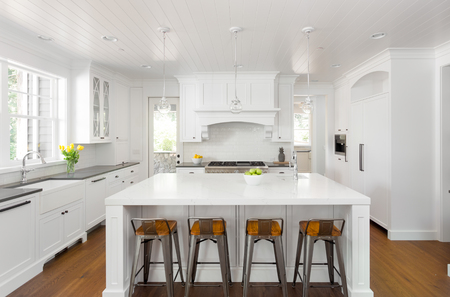
Floor Plans
When reviewing a floor plan designed by an architect or interior designer, you will notice in the kitchen area various line types depicted in the drawing.
On commercial, multi-family, or residential builder drawings, base cabinets are shown as solid lines, and wall cabinets are shown as dashed lines (See Fig. A). Wall lines have thick outlines but are not filled in.
On residential drawings, particularly in association with the NKBA, or National Kitchen and Bath Association, base cabinets are shown as dashed lines, and wall cabinets are shown as solid lines (See Fig. B). Unlike in commercial drawings, wall lines on residential plans are typically filled in except where a door or window is shown.
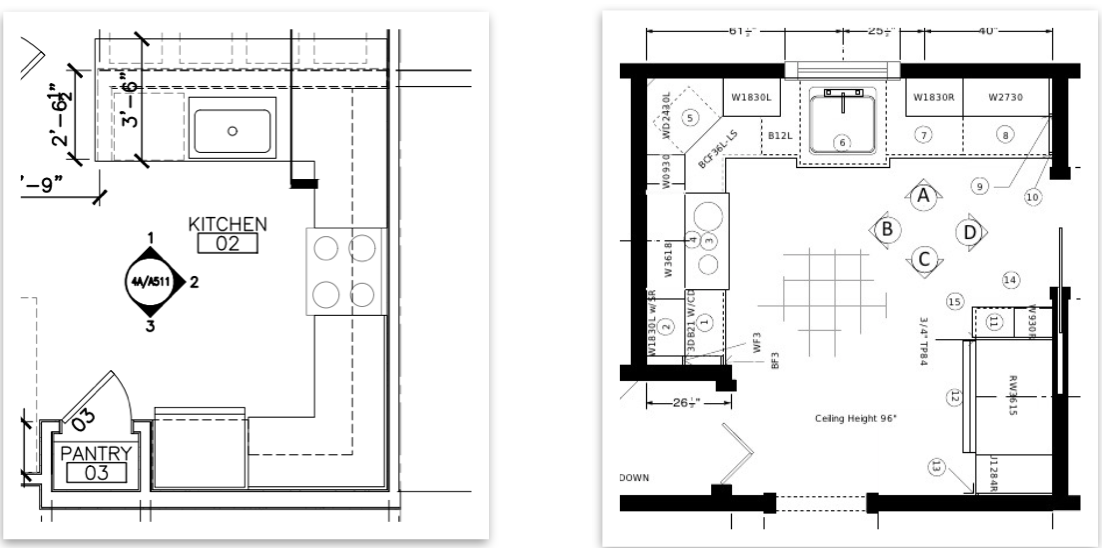
To indicated specific cabinets, nomenclature is shown to represent the type of cabinet and size or width and height. Depending on the manufacturer, cabinets are available in various width increments as well as height for wall cabinets and tall cabinets. For instance, on a kitchen floor plan, you will typically see a base cabinet labeled SB36, B30, 3DB24, and W2442. What the nomenclature above means:
- SB36 = SB stands for Sink Base and 36 means the cabinet is 36” wide.
- B30 = B stands for Base and 30 means the cabinet is 30” wide.
- 3DB24 = DB stands for Drawer Base, 3 in front means it there are three drawers on this cabinet, and 24 means the cabinet is 24” wide.
- W2442 = W stands for Wall, 24 means the cabinet is 24” wide, and 42 means the cabinet has a 42” height.
Cabinetry
There is a multitude of cabinet styles depending on which manufacturer you are designing with. Within each manufacturer, there are a variety of overlays, door styles, wood species, and finishes.
Overlay means how much the cabinet door covers the face of the cabinet, also known as the face frame. There are four main types: traditional, full, inset, and frameless. A traditional or standard overlay shows a 1” to 1-1/2” of the face frame with center stile shown between doors on a cabinet which has two doors. This is also known as a partial overlay. Some manufacturers allow the doors to butt up next to each other leaving a 1/8” gap, where others do not have this option and simply show the center stile. Full overlay shows a ¼” or less of the face frame, allowing the doors to fully encompass the face of the cabinet. Inset shows the cabinet door flush with the face frame, allowing a 1/8” or smaller gap around the door to minimize rubbing. This style can come beaded or non-beaded face frame, and with concealed or non-concealed hinges. Frameless does not have a face frame, and the doors cover most of the cabinet box. The hardware is mounted to the box and allows full access to the cabinet unlike a full overlay where the face frame uses depth space by ¾”.
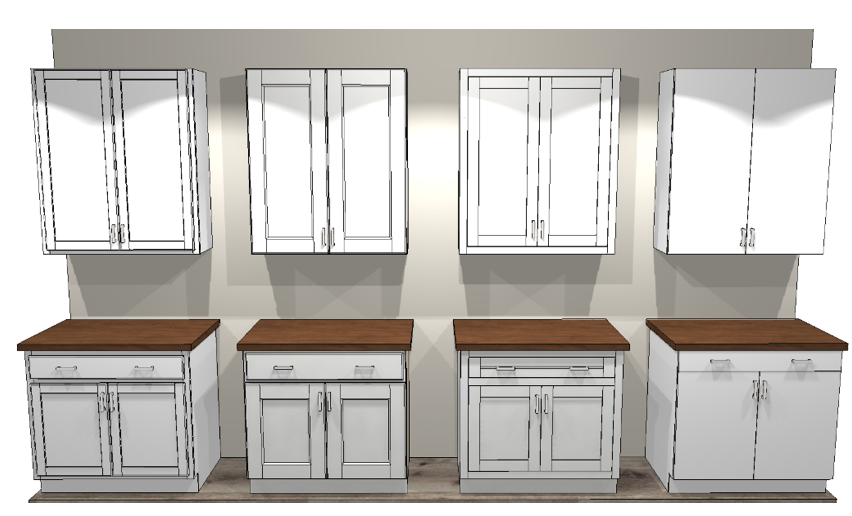
Door styles can range from a raised panel, flat panel, slab, miter, beaded, applied molding, and shaker, with the most popular being shaker.

Wood species can range from oak, hickory, alder, walnut, maple, cherry, laminate, melamine, acrylic, thermofoil, and MDF, with the most popular and most versatile being MDF. MDF, also known as Medium Density Fiberboard, is not to be confused with furniture board or thermofoil. MDF is a composite wood product, performs well in areas where humidity levels vary during the year as it does not expand and contract like solid wood does, and can be painted. Thermofoil is a laminate product, it has limited door styles and usually available only in white. The product ages with time, causing a yellow tone to appear and if in areas with high heat exposure and water splashing, it can cause a ripple or bubble appearance underneath the finish.
Finishes can range from painted, stained, embossed or heavy textured, or gloss laminate, with the most popular being painted finishes.
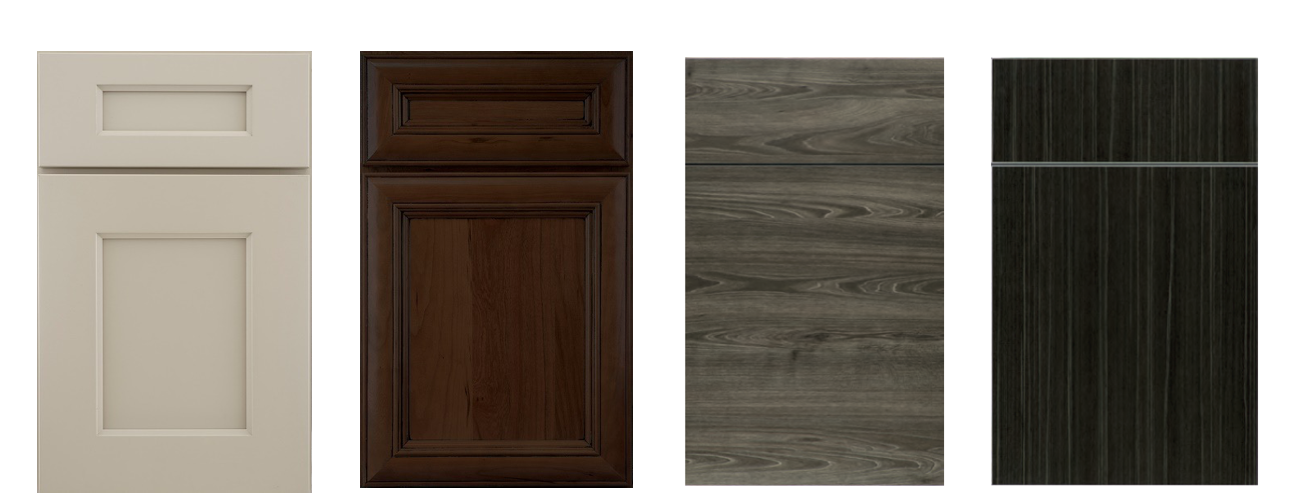
2018/2019 Trends in Cabinetry:
Finishes
Painted finishes are in high demand, especially in white and grey tones. Some designs are accenting specialty areas such as bathroom vanities or bars in colors such as navy or olive green, and the resurgence of medium to dark stains in areas such as hoods, floating shelves, or islands.
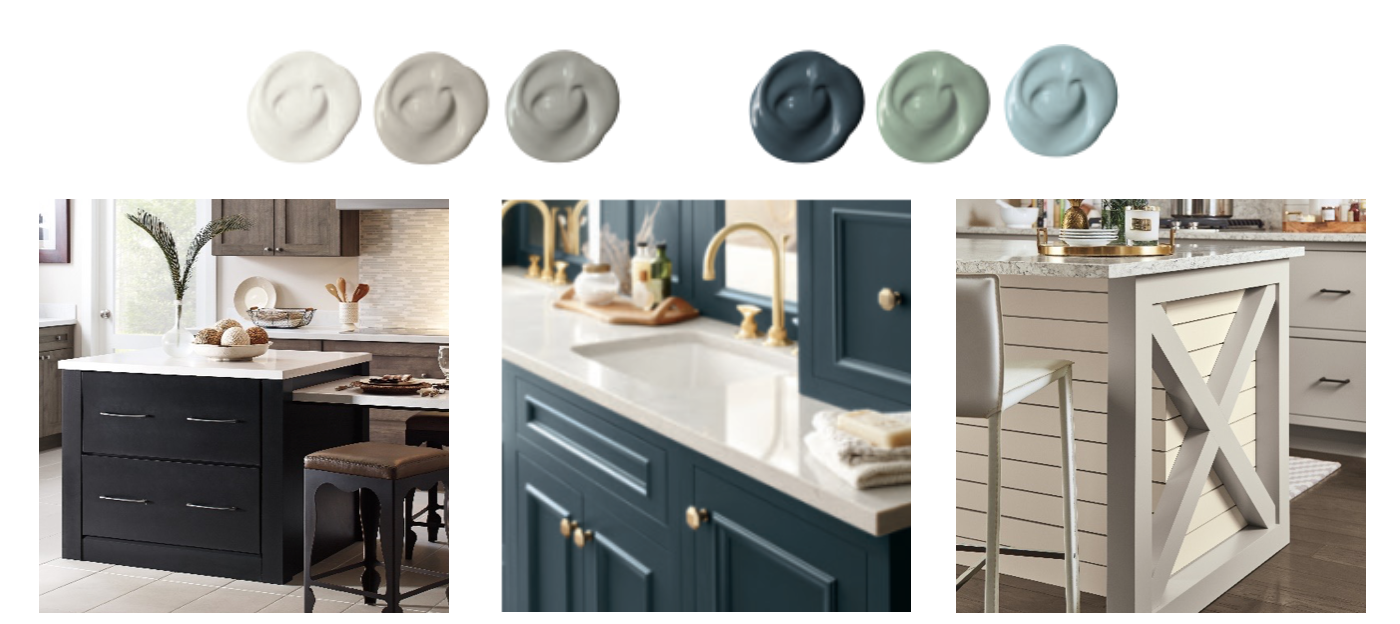
Mixing Finishes and Styles
Two-tone color schemes have been around for a couple decades, usually done with the perimeter and island in separate colors. The newest introduction is mixing two finishes in one area, for instance, the base cabinets and wall cabinets are in separate colors creating a two-tone at an area like the perimeter.

Three and four tone color schemes have emerged introducing a third and fourth finish, accenting as a wall hood, tall cabinetry, floating shelves, or an island. Four tones are fairly new to the market, though this can be done by using complimenting paint and stain colors for walls, talls, and base cabinets throughout the design. For instance, perimeter wall and tall cabinets are light (white), perimeter base cabinets are dark (navy blue), island cabinets are dark stained wood, and accenting floating shelves or wall hood are medium stain with a dark glaze to pull in the island finish.


Countertops
Gone are the days of dark countertops. Not to say there are still kitchens being designed with dark countertop finishes, but homeowners want their kitchens to feel light, bright, and clean. Enter quartz, depending on the manufacturer, this is a man-made material with a mixture of natural quartz. The designs are beautiful, resembling marble without the marble price or maintenance, and the durability is comparable to granite. However, it is not natural stone, so it does not tolerate heat as well as granite and the slabs are all the same. No hunting through the slab yard for the perfect one.

Storage Solutions
We can never have enough storage, and options for interior accessories have grown in the past couple of decades. Not only can you get trash pullouts, drawer pullouts, lazy susan, and cutlery dividers just to name a few, but you can get a vacuum or extra tray storage in your toe kick, a tablet holder for underneath your wall cabinets, and pet feeding station if you have pets. The options are endless!

Hardware
The rise of gold, all shades of gold whether it’s polished, champagne, rose, bronze, or aged. Not to be confused with brass, a popular finish in the ’80s and ’90s, now gold finish has a more refined, true gold color. Bronze and Nickel will never go out of style, although these finishes are getting makeovers of their own. Bronze is embracing a warmer, lighter tone, and nickel is trying a darker approach and going black or even graphite with matte finishes. Marble is also making its way into decorative hardware, paired with metal finishes and geometric shape.
Hardware is the jewelry of cabinetry, it’s a way to express your style without the worry of being permanent. It is also the easiest, least expensive way to revamp existing cabinetry.

To learn more about our cabinetry selection, please visit us here. For countertops, click here. As always please let us know if you have any questions, you can call or visit us for more information. Thanks for reading!
Leave a Reply